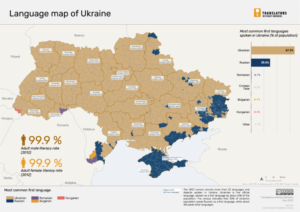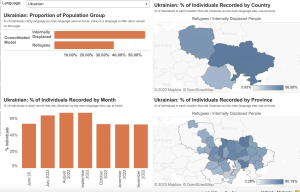Language data for Ukraine
There are approximately 20 languages spoken in Ukraine. According to the 2001 census, 67% of the population speak Ukrainian and 30% speak Russian as their first language. Ukrainian, the official language, belongs with Russian and Belarusian to the East Slavic branch of the Slavic language family. Ukrainian is closely related to Russian but also has distinct similarities to the Polish language. Other minority languages in the country are Romanian (spoken by 0.87% of the population as a first or second language), Crimean Tatar (0.5%), Bulgarian (0.43%), and Hungarian (0.43%).
While the 2001 census records 22,600 Romani speakers, the actual number is estimated to be much higher. The Ukrainian Parliament Commissioner for Human rights estimates that there are between 150,000 and 400,000 Roma across Ukraine.An unknown number of this group speak Romani as their first language. Many Roma don’t publicly identify as Roma or lack identity documentation and are therefore not reflected in the official census data.
According to the constitution, the state has an obligation to ensure the comprehensive development and functioning of the Ukrainian language in all spheres of social life, while guaranteeing the free development, use and protection of the Russian language and other languages of national minorities.
Language data allows humanitarian organizations to better understand the languages people speak and understand, leading to better programming and accountability. We’re working with University College London’s Centre for Translation Studies and others to make language data more easily accessible and usable.
For more information, contact info@clearglobal.org.
Maps and resources:
Static map highlighting the most common languages spoken in Ukraine. Data is from the 2001 census.
Interactive map showing the number of speakers and geographic spread of different languages in Ukraine. Data is from the 2001 census.
An interactive data platform designed for responders. We combine multiple sources to give a complete and up-to-date view of the languages and communication channels used by people affected by the war in Ukraine.


